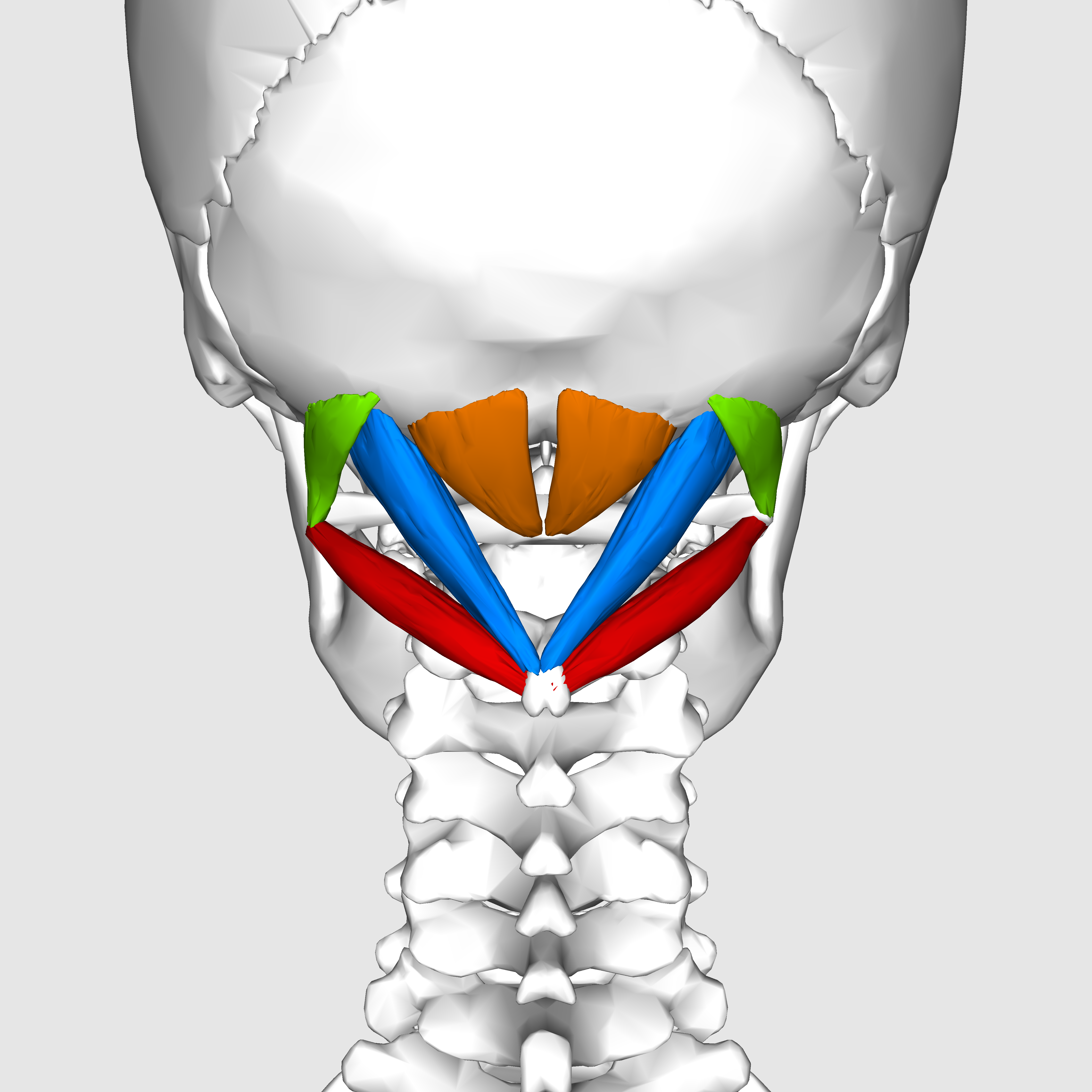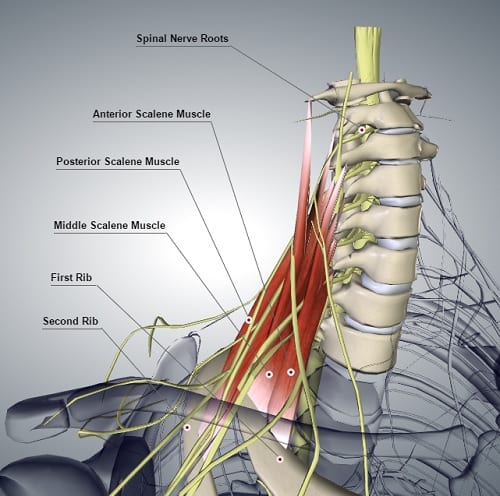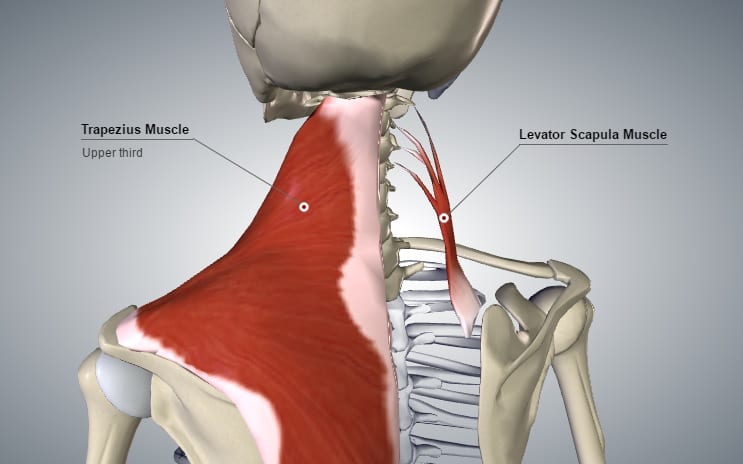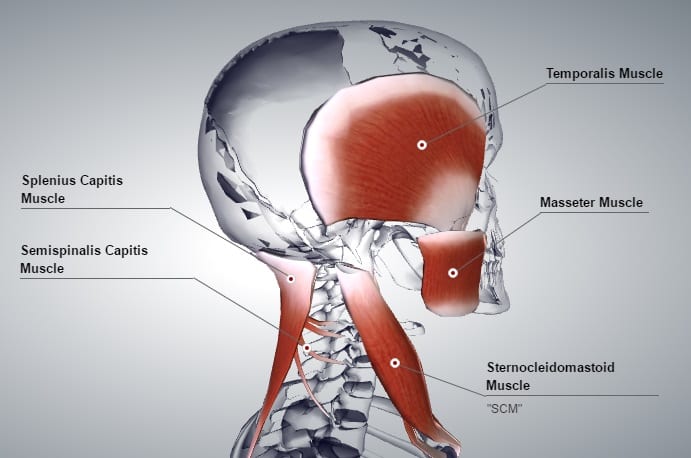There are several possibilities for which muscles may be involved in a headache or migraine pattern, and we can use assessment and your history to zero-in on which ones they are.
The most common muscular sources of headache pain are the suboccipital group (see image below), consisting of four small muscles at the base of your skull; the upper trapezius; the scalene group on the side of the neck; and the muscles of the jaw.
Suboccipital Muscles and the Dura Mater of the Brain

The suboccipitals are often short and tight when your head and neck come forwards, which is so common with computer work or when driving. It’s incredibly rare that I meet someone in Melbourne who does not have a forward neck posture!
Additionally there is a fibrous tissue connection between the suboccipital muscles and the covering of the brain (the dura mater), so that when the muscles pull the dura it tightens over the brain itself. This constriction can lead to an all-over headache.
Upper Trapezius and Throbbing Headaches
Similarly, having hunched shoulders can cause the upper trapezius and levator scapulae muscles to become shortened, tight, and over-active. Trigger points in the upper trapezius are often linked with a throbbing headache behind the eyebrows. Trigger points in the levator scapulae muscles are linked to headaches behind the ears, and can also feed into the upper trapezius trigger points.
It’s fairly easy to assess for a trigger point – it’s defined as a palpable nodule in a tight band of muscle tissue that is tender to the touch and when irritated radiates pain down a predictable nerve pathway. In this case, the radiation of pain (called a pain referral pattern) refers the pain into the head.
The Scalenes and Needling Headaches
The scalene muscles are located on the sides of your neck. They have two main jobs: first, the flex your head to either side. Second, because they attach to the top of your rib cage, they assist with deep breathing by lifting the ribs.
These muscles can become shortened, tight, and over-active if you (once again) have a forward neck posture, hunched shoulders, or if you hold your phone to your ear with your shoulder. They can also become over-active if you are slouched over for long periods, which compresses your abdomen and inhibits the action of your diaphragm – your primary breathing muscle.

Tight scalenes can pull on the sides of your neck vertebrae, compressing the discs and your spinal nerve roots causing irritation. This nerve root irritation can cause headaches with a needling sensation in the base of the skull.
If there are trigger points in the scalenes then there may be referred pain into the shoulder and arm, so if you have these sensations as well then you are probably suffering from tight scalene muscles.
Jaw Muscles, Bruxism, and Headaches in the Temples
There are several muscle implicated in this pattern, but the main ones are the masseter, the temporalis, and the sternocleidomastoid (SCM).
The masseter is often responsible for the condition of bruxism, or unconscious teeth clenching. It is the muscle capable of generating the most force (in Nm), weight-for-weight, of all the muscles in your body, so it is very, very strong.
When your masseter is over-active it has knock-on effects into your temporalis muscle, and it is here that trigger points then refer headache type pain into the skull and head, especially on the sides. Sometimes people also feel strange pain in their teeth when the temporalis is irritated.
The SCM is also a “usual suspect”. This is the muscle that primarily pulls your head forwards when you have forward neck posture, so it is often shortened and over-active.
Trigger points in the SCM can cause headache type pain behind the eyes, behind the ears, and sometimes the feeling of having an ear ache.
The Capital Muscles
Finally, the splenius capitis and the semispinalis capitis, two long muscles that go from your upper back to the back of your skull and hold your head up, can end up over-worked and generate trigger points. The referred pain pattern is often into the crown of the head.
Assessment and Treatment
We can use movement testing (active, passive and resisted ranges of motion) to identify which of these muscles may be causing your headache or migraine pain. The jaw muscles and the suboccipital muscles in particular have been linked to migraine and tension type headaches.
Treatment of these kinds of problems usually requires a gentler approach. While some of the trigger point releases can be tender and intense, it should only ever be to a tolerable level, in a way that feels strangely good and beneficial.
Over-treating these hyperactive muscles can potentially make the headaches worse.
So long as you are comfortable there will probably be a lot of therapeutic stretching of the muscle involved during the treatment as the muscle release. We may also do some gentle joint mobilisations in the neck and jaw to calm down over-active muscles or nerve roots.
If you feel at all uncertain about any stage of the treatment, you should tell your therapist so that they can adjust.
I hope that all makes sense! Shoot me a message if you have any questions.



